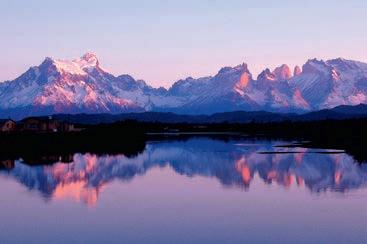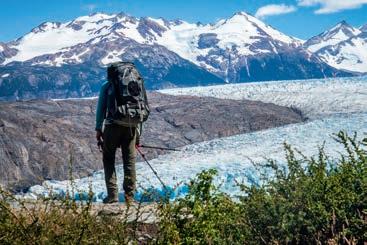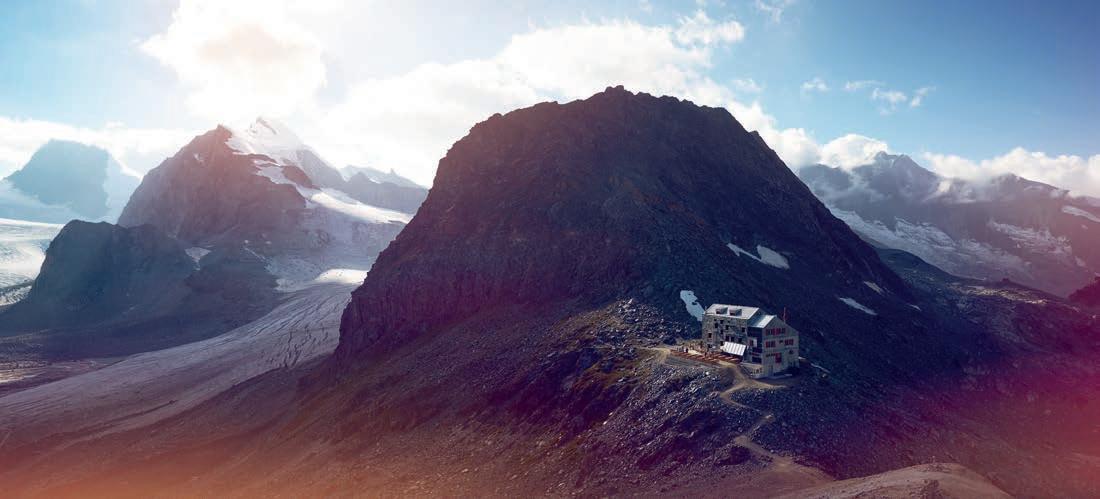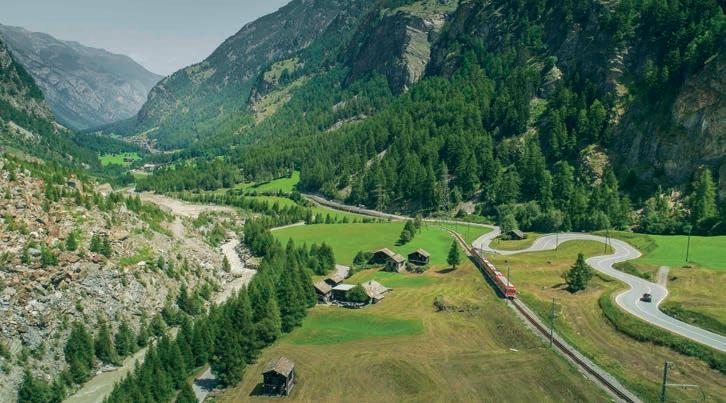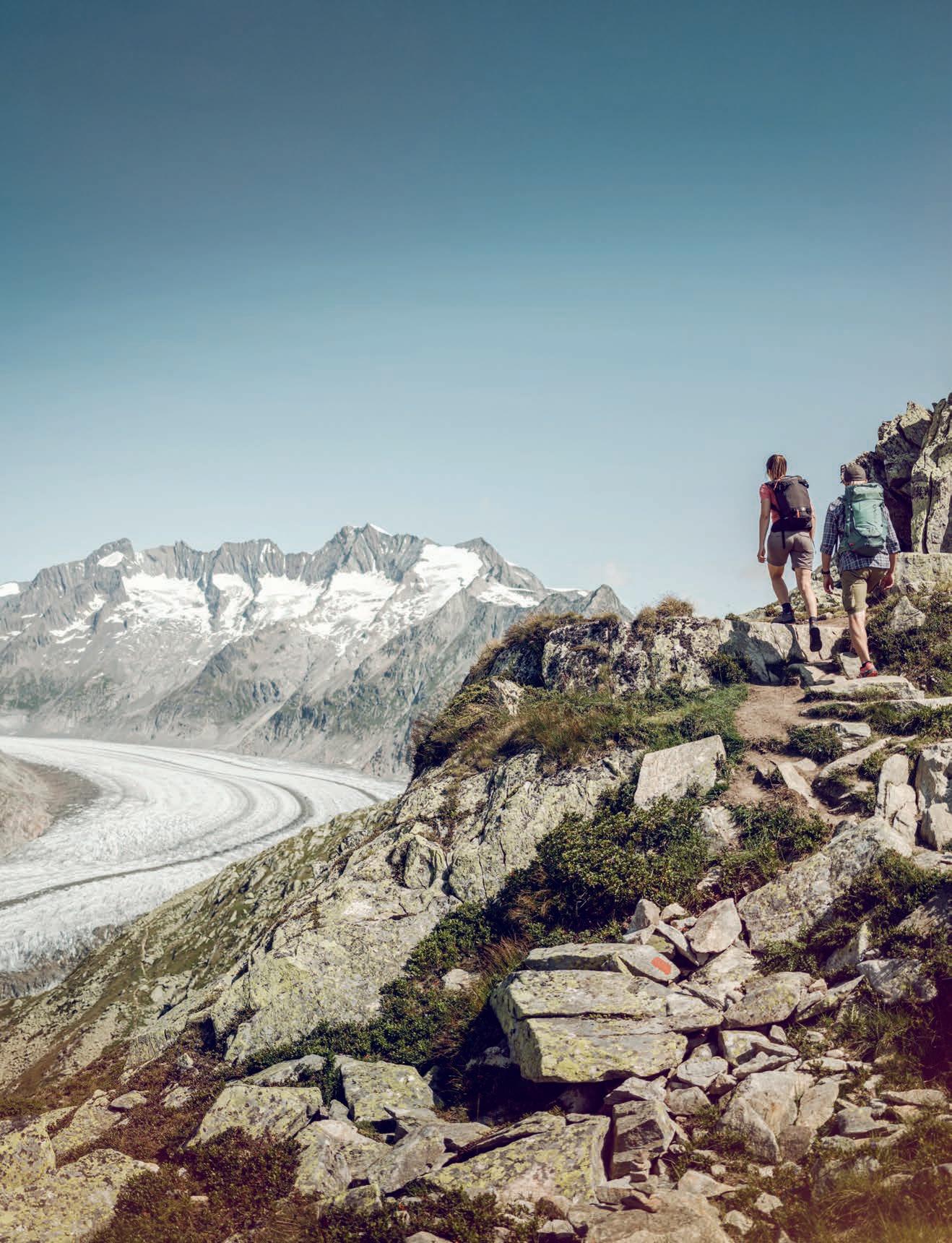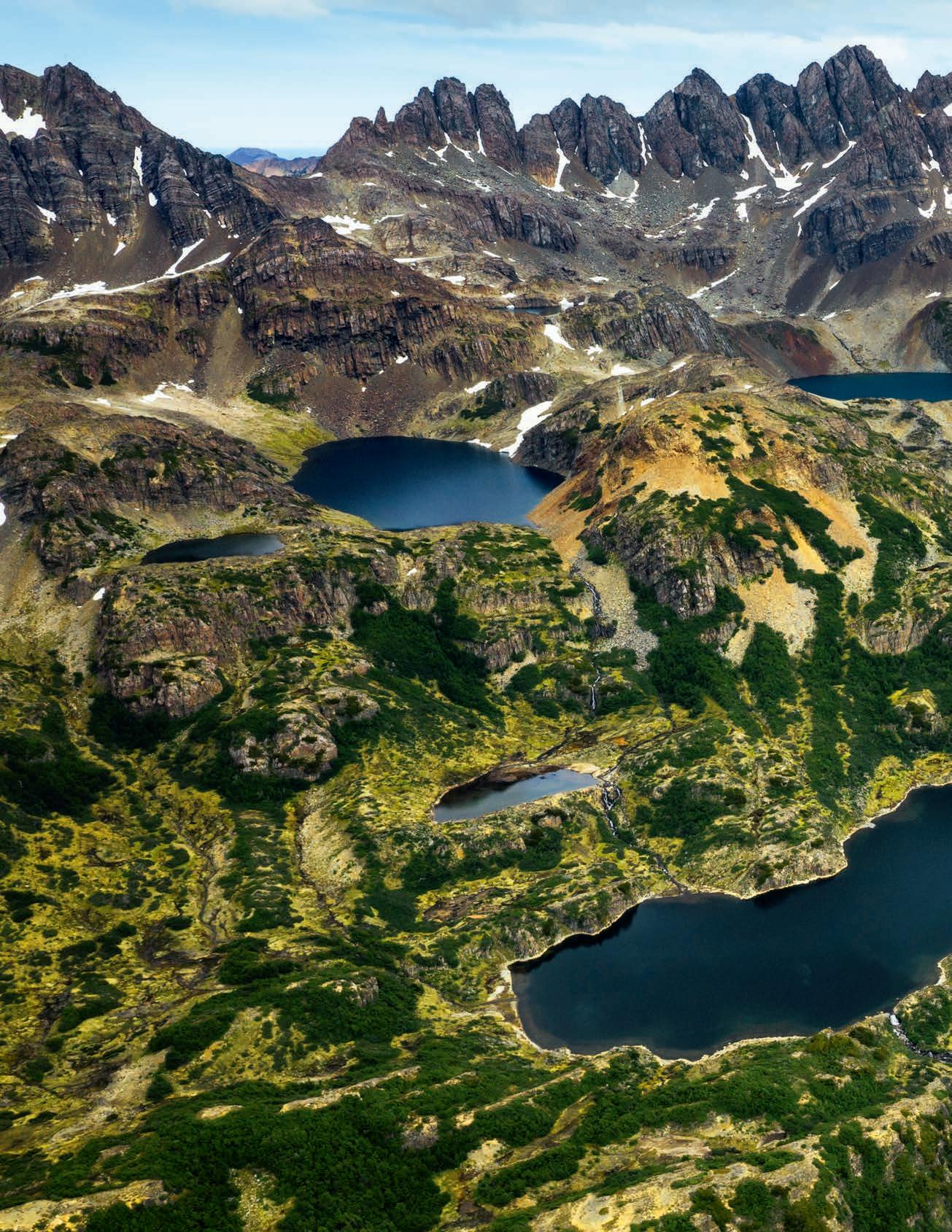
18 minute read
Tierra del Fuego
A journey to the end of the world
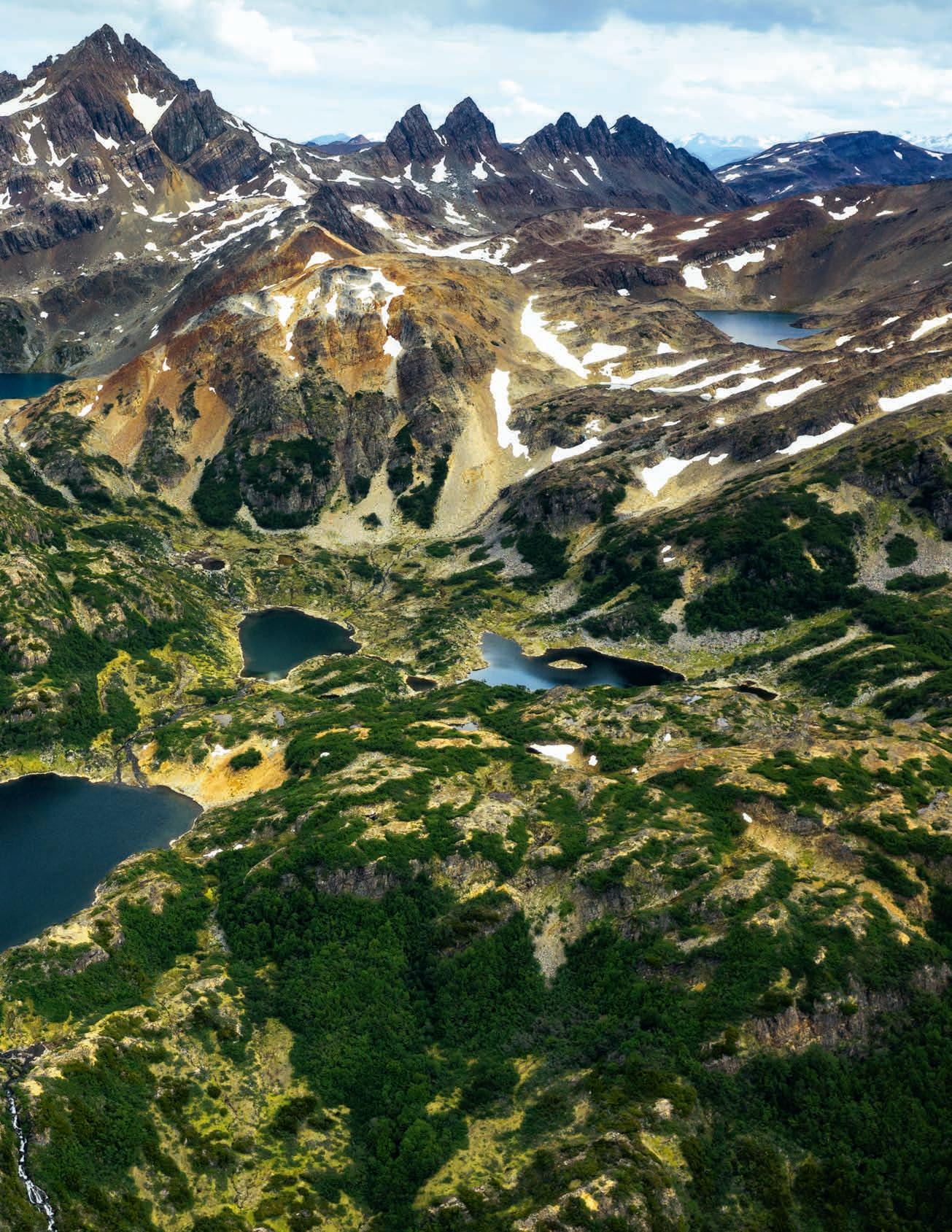
Advertisement
Chilean Tierra del Fuego is a wild, remote and storied land, home to the southernmost city and trek on the planet
Words Shafik Meghji
igh above the glinting rooftops of Puerto dissolving completely into the Southern Ocean. Divided Williams, the summit of Cerro Bandera between Chile and Argentina, Tierra del Fuego (‘Land of
H– ‘Flag Hill’ – was dusted with snow, Fire’) is one of the world’s last surviving wildernesses. racked by gale-force winds and utterly Most travellers only visit the Argentine section of the archideserted. Still puffing from a precip- pelago, flying in and out of the port city of Ushuaia. Once itous hike through a forest of beech a missionar y settlement, then a notorious penal colony trees, I sheltered behind a half-col- dubbed the ‘Siberia of the South’, Ushuaia is the starting l a p s e d c a i r n point for most Antarctic cr uises. a n d wa t c h e d “Tierra del Fuego’s But to really experience life in this a faded Chilean flag thrash at its pole like a fish on a hook. Nearby, a stream turbulent history far-flung region, you need to continue south across the Beagle Channel to of snow-melt trickled over the stony encompasses the Chilean island of Navarino. Its terrain, which was chequered with missionaries, gold little-visited capital, Puerto Williams, moss, the only plant hardy enough to was upgraded to city status by the grow in the sub-polar tundra. rushes, epidemics, Chilean authorities in 2019, despite
To the nor th, on the opposite polar explorers and having a population of barely 3,000. shore of the Beagle Channel, was the Argentine side of Tierra del Fuego, the devastating rodents” This redesignation allowed it to claim the coveted title of most southerly southernmost tip of South America. city on Earth from its far larger, and
I snapped a few photos before turning 180 degrees to face the now rather miffed, rival Ushuaia.
Dientes de Navarino, a range of fang-like mountains, the last But while I was initially drawn to Puerto Williams by gasp of the Andes. Aside from a few Chilean naval officers on its sense of isolation, during my three-night stay I found
Cape Horn and a handful of scientists at Antarctic research I became increasingly captivated by Tierra del Fuego’s stations, there was nobody between me and the South Pole. turbulent histor y, which encompasses scientific expe-
Beneath Patagonia, across the choppy Strait of Magellan, ditions, missionaries, gold rushes, ranchers, epidemics,
South America crumbles into a labyrinth of sparsely popu- repression, polar explorers and devastating rodents. At the lated islands, rocky outcrops and serpentine channels before heart of these tales are the region’s often overlooked ⊲

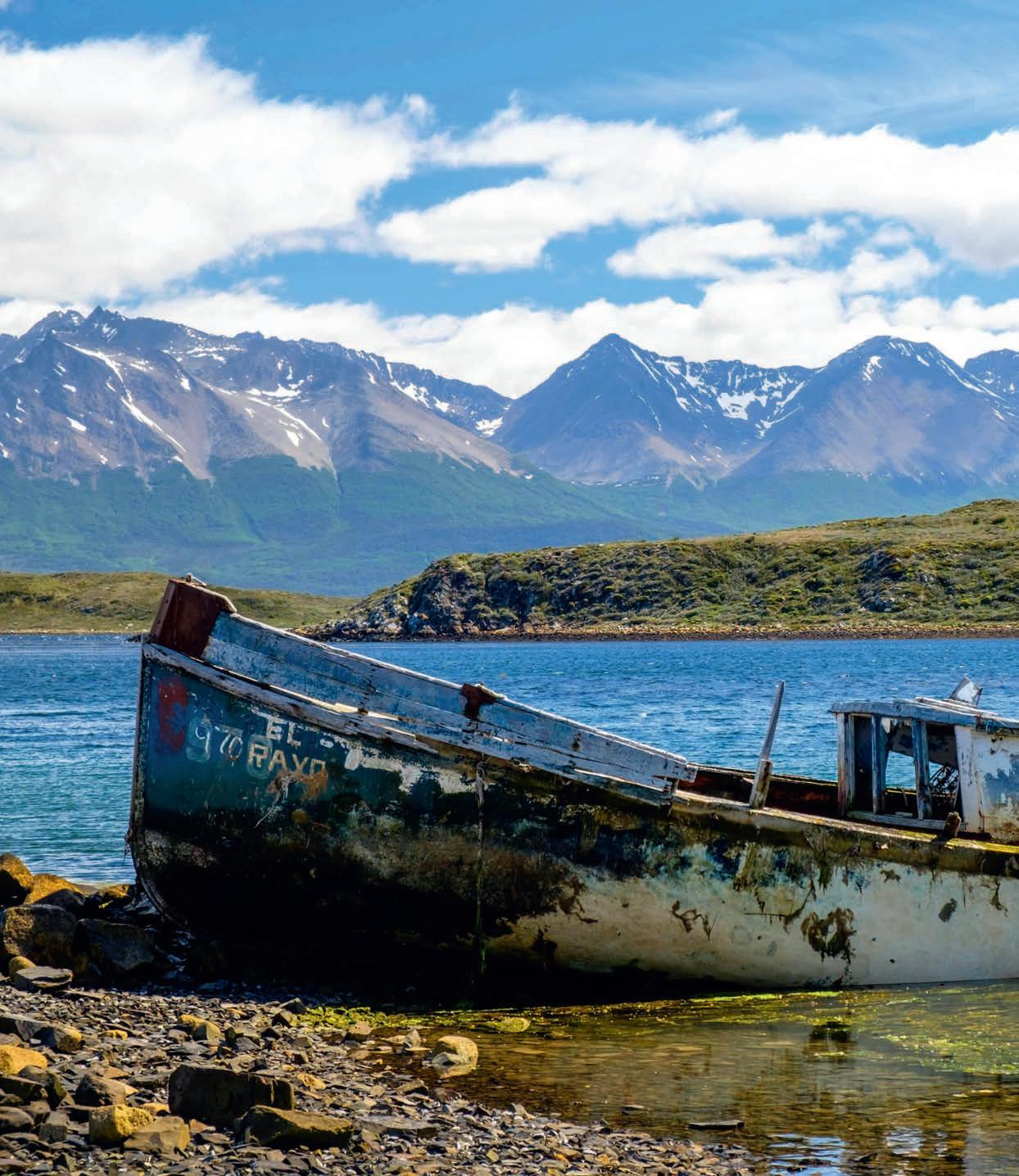
Hazardous waters
The wreck of a boat lies on the shore of the Beagle Channel, near the small Chilean border post of Puerto Navarino Indigenous communities. The more I learned about them, the further I wanted to explore.
FIN DEL MUNDO
Unless you fly, getting to Puerto Williams takes time, patience and a degree of luck. The first stage of my convoluted journey – made before the pandemic – started in Punta Arenas, a Chilean Patagonian city whose stately architecture is testament to the wealth generated by the sheep-farming boom of the 19th and early 20th centuries. I caught a bus east to Punta Delgada, where we joined a motorcycle club for the ferry ride across the Strait of Magellan to the Chilean section of Isla Grande, Tierra del Fuego’s largest island.
The landscape resembled the steppe that spans much of southern Patagonia: solitary estancias, flocks of sheep, shallow grey lakes and the occasional skittish guanaco, a wild cousin of the llama. After crossing into Argentina at the San Sebastián border post, the bus bore south along Ruta Nacional 3, the final leg of the Pan-American Highway. We pulled into Ushuaia in the early evening, 11 hours after setting off from Punta Arenas. A sign at the port announced we had reached the ‘Fin del Mundo’ – End of the World.
After a bout of stormy weather – not uncommon in Tierra del Fuego, even in the summer – the next morning was sunny and still. For the first time in a week, the Beagle Channel was calm enough for the Cruz del Sur motorboat to make the 45-minute crossing to Isla Navarino. En route we spotted colonies of sea lions sprawled along the uninhabited islets dotting the waterway.
I was the first foreign arrival at the Puerto Navarino border post for nine days. As the immigration officer checked my passport, a fisherman hauled a net of writhing centollas – king crabs – onto the slippery dock. It was a one-hour drive to Puerto Williams along a gravel road. Hugging the shoreline, Argentina’s snowy peaks still visible across the water, we passed empty coves, clumps of orangey-red Chilean fire bushes, and trees leaning at 45-degree angles, sculpted by the near-constant winds. Ancient middens – mounds of mollusc shells discarded by Indigenous communities over the centuries and then gradually overgrown – formed a series of gently undulating hills.
Thick forest lined the road, but patches appeared to have been struck by a hurricane. These tangles of broken branches and denuded trunks were actually the work of the descendants of 20 Canadian beavers introduced to Tierra del Fuego in the 1940s by the Argentine government in an attempt to develop a profitable fur trade. It was a catastrophic mistake: the industry floundered and the beavers took advantage of the lack of predators, reproduced prodigiously and spread across the archipelago. Despite eradication efforts, they now number around 200,000 and are estimated to have damaged a quarter of the region’s forests.
Periodically, we passed lonely houses, but didn’t see another vehicle on the road until Puerto Williams. Overlooking a shallow bay, the city was shielded by the looming Dientes – “Teeth” – of Navarino, their dark flanks streaked with snow.
1,000KM NORTH OF ANTARCTICA
Founded in 1953 to serve as a naval base, Puerto Williams is less than 1,000km north of Antarctica; Santiago, by contrast, is more than 2,400km away. Although officially classed ⊲
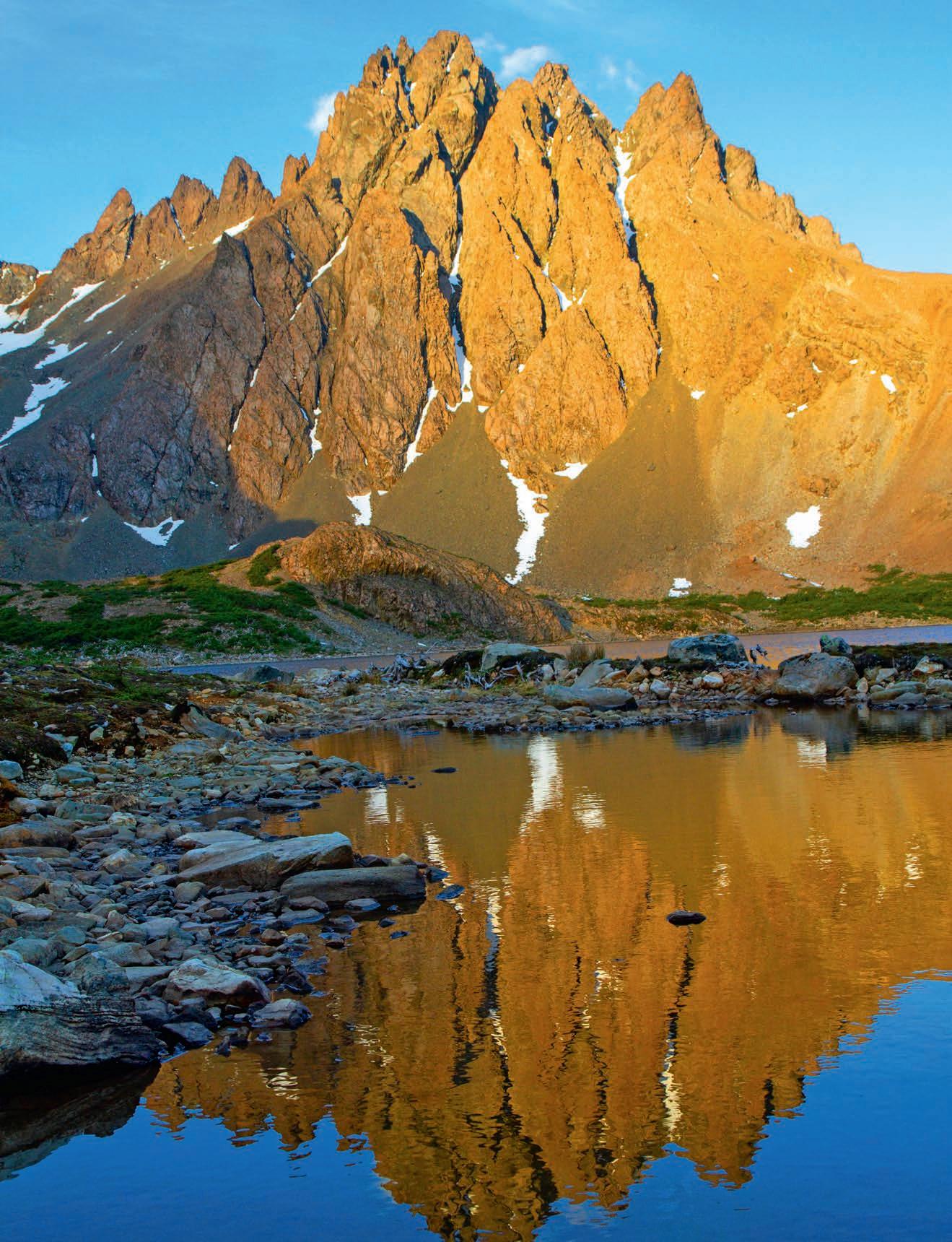
as both a city and the capital of Chile’s Antarctic province, it resembles a small frontier town.
The naval officers and their families, the majority of the population, live in a grid of identikit houses with white walls, picket fences, well-tended lawns, Chilean flags and, more often than not, a dog house. Beyond them is a jumble of one- and two-storey homes with corrugated iron roofs, oversized satellite dishes and piles of firewood, interspersed with a few A-frame churches, some simple guesthouses and a dozen shops and restaurants. Stray horses roam the streets, pausing to nibble at daisies poking out of the dirt. Passersby invariably say hello.
“This is a tranquil place,” said the owner of the Minimarket Yagán. “We have no delinquency – people leave their keys in their cars and their front doors unlocked. It’s a real community.” Puerto Williams is also more cosmopolitan than you might expect. Over a lunch of grilled chicken and salad at a Colombian-run cafe, I chatted with Laura Ogden, a cultural anthropologist at Dartmouth College in the USA. A regular visitor to the city, she was working on a research project with the Indigenous Yagán community and writing a book about Tierra del Fuego. I later met an Estonian researcher who was studying the geopolitics of Antarctica.
Nearby, guarding the entrance to the naval base, was another link with the wider world: the grey-and-black prow of the Yelcho. This Chilean naval tug played a key role in one of the famous stories of polar exploration of the 20th century. In 1916, it rescued 22 members of Ernest Shackleton’s ill-fated Endurance expedition, who had been stranded on desolate Elephant Island for four and a half months.
As the sun set, a flotilla of fishing boats – which, alongside the navy and tourism, provide most of the jobs in Puerto Williams – cast long shadows on the pebble beach. A pod of dolphins skimmed across the Beagle Channel, while petrels, gulls and oystercatchers flashed through the darkening sky. A GRANDMOTHER FIGURE The next morning, I visited the Museo Antropológico Martín Gusinde to learn about the history of Tierra del Fuego. Through exhibits such as a Yagán canoe and a set of finely worked bone harpoons, it shows how Indigenous peoples have lived in the region for more than 10,000 years, creating flourishing societies in some of the harshest environments imaginable. The first European settlers were British Anglican missionaries, who arrived in the mid-19th century. Some of them lived in Casa Stirling, a prefab cast-iron house that now sits in the museum’s grounds. They were followed by waves of Europeans and South Americans eager to make their fortunes from sheep ranching and gold mining. This devastated the Indigenous population: many died of diseases such as measles and smallpox brought over by the settlers; others were killed or displaced by ranchers and bounty hunters. It is often described as a genocide.
Today, only small Indigenous communities remain in Tierra del Fuego, notably Villa Ukika on the eastern outskirts of Puerto Williams. Founded in the 1960s, it is home to around 50 Yagán residents, a community centre and the Kipa-Akar, a replica of a traditional Yagán dwelling that sells arts and crafts. Villa Ukika’s most famous resident is Cristina Calderón, who Ogden described as a “grandmother figure for the whole community”. As we chatted in her living room, Calderón showed me a book about her life and some of the items – socks, gloves, scarves – she had knitted. “Puerto Williams is a very beautiful place,” she said. “Now there is lots of work going on, and they are building new things. There’s lots of change.” The Yagán community has long been overlooked, but awareness has grown in recent years, thanks to a successful campaign to prevent the opening of a huge, and potentially destructive, salmon farm near Puerto Williams. This attracted widespread media
“From the summit of attention, as did the 2021 election of Cerro Bandera, the view Calderón’s daughter, Lidia González Calderón, to represent the Yagán provided a snapshot people in the citizens’ assembly that of sloping scree, will draft a new Chilean constitution. dark-green moorland, DEVELOPING FAST crystalline lakes and the Beyond its str iking histor y and
Dientes mountains” sheer remoteness, Puerto Williams is sur rounded by some of South America’s most dramatic landscapes. On my final day, I hiked the first section of the Dientes de Navarino circuit, one of the continent’s most challenging treks, following a woodland trail scattered with dandelions, passing a cascading river and patches of beaver destruction. From the summit of Cerro Bandera, the view south provided a snapshot of the trek as a whole: sloping scree, dark-green moorland, dense forests, crystalline lakes and the sight of the Dientes themselves. I only saw one other hiker, but back in Puerto Williams the streets were unexpectedly crowded. A cruise ship heading to Cape Horn had docked for the afternoon, disgorging a stream of red-jacketed passengers. It was a reminder that, although neglected by the Chilean authorities for much of its existence, Puerto Williams is developing fast. The waterfront hummed with construction work, there was a new elevated boardwalk, and a health clinic was in the pipeline. This is just the start. Over a dinner of centolla gratin, I read in a local newspaper about plans for a large, modern dock to allow bigger ships – including touristic and scientific vessels bound for Antarctica – to visit the city. Although tourism was slowly increasing before the pandemic, Puerto Williams still feels like the end of the world. But as I waited for my flight back to Punta Arenas, I learned there is actually another settlement slightly further south. At the one-room airpor t, I scanned a map until I found Puerto Toro, wedged into an inlet on Navarino’s south-east coast. Only accessible by boat – though a road to Puerto Williams is currently being built – the hamlet’s population hovers around 50, though can double during the lucrative centolla-fishing season. I briefly entertained the idea of skipping the flight and chartering a boat to visit, before the boarding announcement ended my reverie. It was probably for the best. No matter how far you travel, there’s always further to go. ⊲
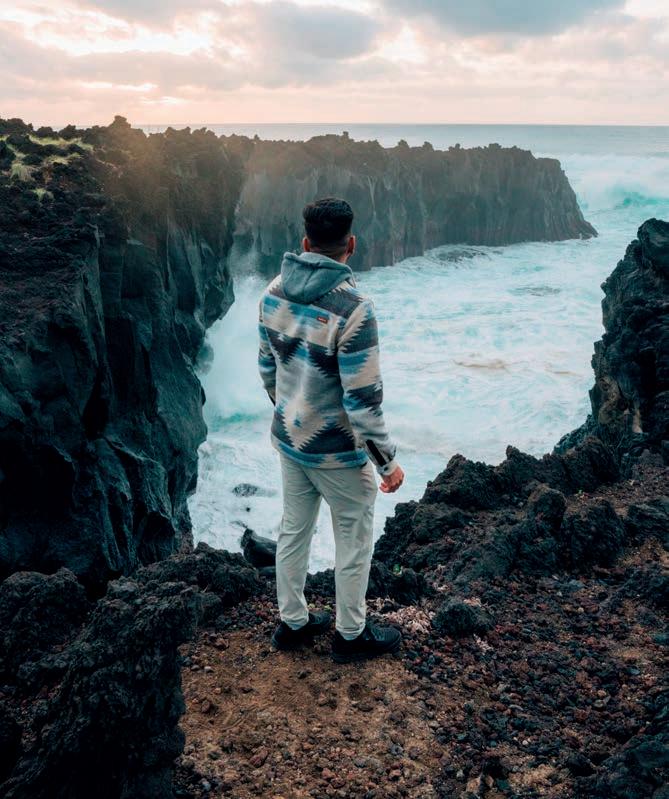

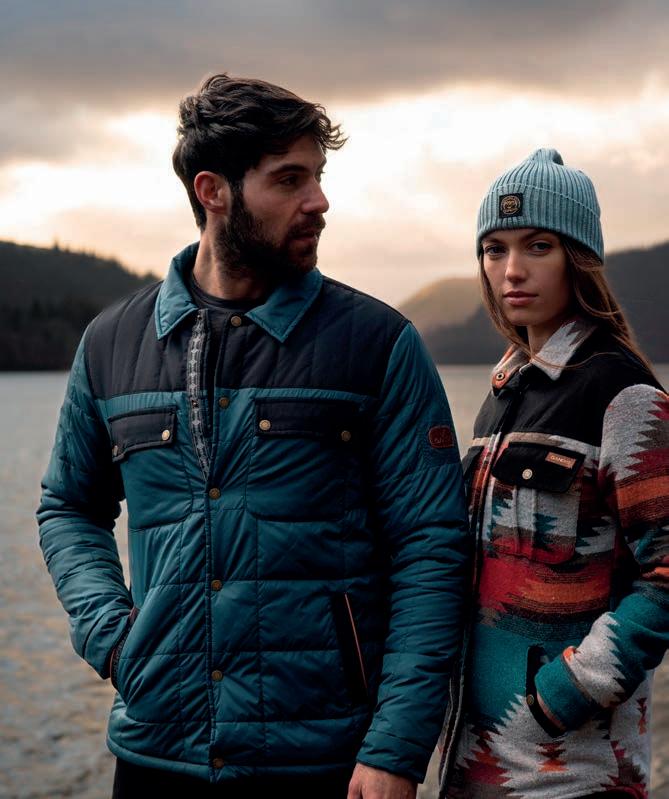
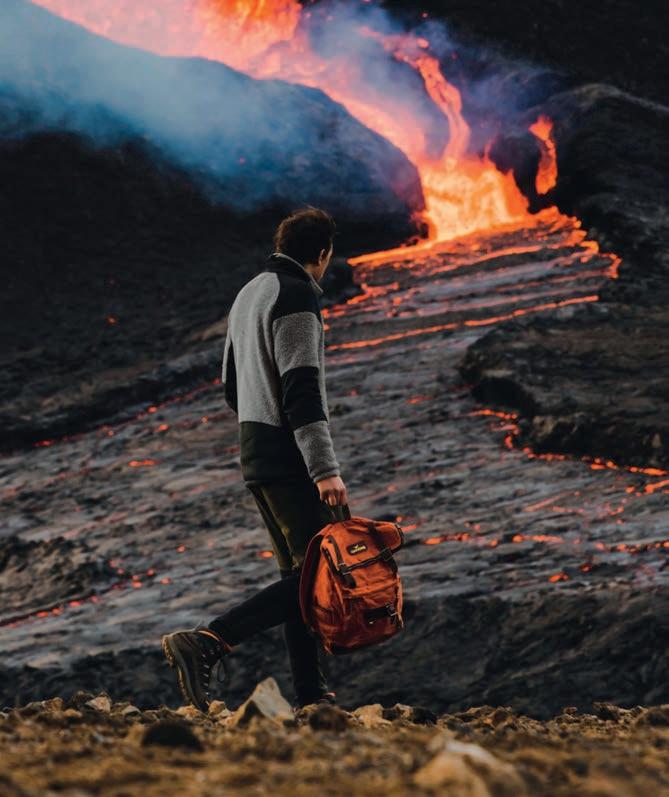

THE TRIP
The author’s accommodation in Ushuaia was provided by Arakur Ushuaia Resort & Spa (www.arakur.com; +54 2901 44 2900) and in Punta Arenas by Chimu Adventures (www.chimuadventures.com; 020 7403 8265). He did the rest of the trip independently.
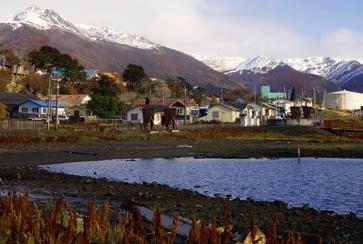
Vital statistics
Capital: Santiago Population: 19.1 million Language: Spanish Time: GMT-4 (summer GMT-3); Southern Patagonia and Tierra del Fuego GMT-3 year round International dialling code: +56 Visas: Not required by UK nationals (in Chile or Argentina) for stays of up to 90 days. Money: Chilean peso (CLP), currently around CLP1,087 to the UK£. There is an ATM in Puerto Williams but it sometimes runs out of money, so bring a steady supply of cash with you. Punta Arenas and Ushuaia, on the other hand, have plenty of banks and ATMs.
When to go
Puerto Williams (pictured left) is at its best – and typically most accessible – during the summer months. November to March: The warmest period of the year. Daytime temperatures range from 5°C to 21°C, though can fall to below zero at night. January–March is peak tourist season. April to October: Daytime temperatures drop to between -1°C and 19°C, with June, July and August the coldest months. Snow, rain, wind and erratic transport connections can make travel a challenge.
Health & safety
Foreign nationals entering Chile must have a negative PCR test performed 72 hours before departure, be fully vaccinated, fill out an online “Traveller’s Affidavit” form, have health insurance covering COVID19, then complete a PCR test on arrival and quarantine until a negative result is obtained. Visit https://chile.travel/en/ traveltochileplan for more information. Visitors entering Argentina must be fully vaccinated, have a negative PCR test performed within 72 hours of departure
or an antigen test taken in the country of origin 48 hours prior to travel. They must also fill out an online “Sworn Statement” and have medical insurance covering COVID-19. Visit www.argentina.travel for more information.
Travellers should also be up to date with all the routine boosters and immunisations required in the UK, including diphtheria, hepatitis A and tetanus.
Getting there
British Airways (0344 493 0787; britishairways.com) flies direct from London Heathrow to Chilean capital Santiago. Flight time is roughly 14 and a half hours; return fares start at around £660. There are regular local flights and longdistance buses from Santiago to Punta Arenas, from where travellers have three options for reaching Puerto Williams: DAP (+56 61 222 9936; dapairline.com) flies six times a week during the summer; TABSA (+56 61 272 8100; tabsa.cl) runs one-to-two ferries a week during the summer; and several bus companies travel to Ushuaia (Argentina), from where agencies such as PiraTour (+54 02901 435557; piratour. net) offer boat and minibus connections to Puerto Williams. Transport services are severely restricted during the winter.
Getting around
Puerto Williams is easy to explore independently on foot. SIM Expeditions (simexpeditions.com) organises guided Dientes de Navarino circuit hikes and activities such as kayaking, horseriding and fishing, as well as sailing trips around Cape Horn. Hostal Akainij (+56 61 262 1173; turismoakainij.cl) offers trekking, horseriding, and excursions focused on Yagán culture and history.
Cost of travel
Puerto Williams is more expensive than equivalent cities and towns in Chilean Patagonia, but accommodation and food costs are generally lower than in Western Europe or North America. Lunch or dinner costs around £7–17 per person, and it is possible to self cater.
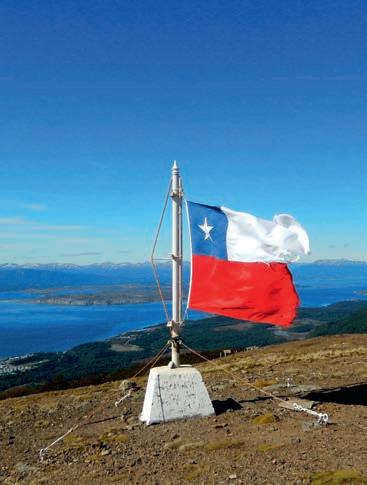
Accommodation
Puerto Williams has limited accommodation options. The smartest and most comfortable place to stay is Lakutaia Lodge (+56 61 262 1721; lakutaia.com), where doubles cost around £200. There are also several basic but welcoming and centrally located guesthouses with doubles in the £40–65 bracket, including Residencial Pusaki (+56 61 262 1116) and Hostal Akainij (see ‘Getting Around’). Ushuaia and Punta Arenas have scores of hotels, hostels and guesthouses for all budgets.
Food & drink
Sampling the locally caught centolla, also known as Chilean king crab, is a particular highlight on any visit to Puerto Williams. Measuring up to a metre from the tip of one leg to another, these monster-sized crustaceans are often served in a gratin or as part of a pasta dish. Other fish and seafood options are available, alongside Patagonian lamb, steaks and pizza.
Further reading & information
Chile and Easter Island (DK Eyewitness, 2020) co-written by Shafik Meghji, author of this article. Chile & Easter Island (Rough Guides, 2018) co-written by Shafik Meghji Loss and Wonder at the World’s End by Laura A Ogden (Duke University Press, 2021) Memorias de Mi Abuela Yagan Cristina Calderón (Memories of My Yagan Grandmother Cristina Calderón) by Cristina Zárraga (Ediciones Pix, 2017; only available in Spanish) www.chile.travel – for official tourist information on Chile www.argentina.travel – for official tourist information on Argentina
Caught in the breeze
The Chilean flag flies high atop Cerro Bandera, where views gaze over the Beagle Channel below
SOUTHERN PATAGONIA HIGHLIGHTS
1Beagle Channel Stretching for more than 240km through Tierra del Fuego, this channel teems with marine life, including sea lions, fur seals, dolphins, penguins and several species of whale.
2Cerro Bandera After a steep climb up to the summit of Cerro Bandera, hikers are rewarded with superb views of Puerto Williams, the Dientes de Navarino, Beagle Channel and the snow-covered mountains that line the Argentine coast of Isla Grande.
3Museo Antropológico Martín Gusinde
This modern museum provides an insight into the history of Tierra del Fuego and the societies and cultures of its indigenous peoples.
4Villa Ukika On the eastern edge of Puerto Williams, this small Yagán community is home to the KipaAkar, a replica of a traditional house that sells arts and crafts.
5Puerto Toro Founded in 1892 during the Tierra del Fuego gold rush, tiny Puerto Toro is the most southerly permanent settlement on Earth. Home to a handful of centolla fishermen and their families, it is only reachable by boat.
6Ushuaia As well as having excellent restaurants and a fine museum, this Argentine city is the gateway to Tierra del Fuego NP and the Tren del Fin del Mundo, the world’s southernmost railway.
WANDERLUST
RECOMMENDS
Chile: Wanderlust Travel Guide – https://www.wanderlust.co.uk/ destinations/chile Argentina: Wanderlust Travel Guide – https://www.wanderlust.co.uk/ destinations/argentina
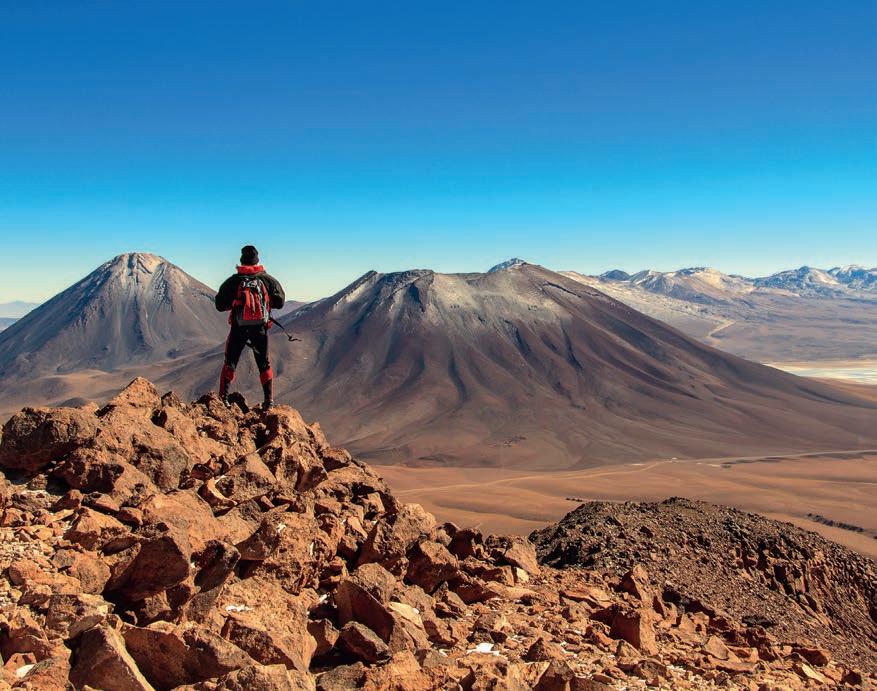
Dazzling diversity
(clockwise from this)The active Licancabur volcano near San Pedro de Atacama; Grey Glacier in Torres del Paine National Park is more than 30m high; sample world-class wines in central Chile; the view of Torres del Paine from Hotel Rio Serrano
Chile: Where the impossible is possible
4 adventures from north to south…
With its wild blend of deserts, rainforests, beaches and volcanoes, this diverse country offers an eclectic mix of lifeaffirming experiences and thrilling activities. Here’s what to expect...
THE DESERT
As one of the driest places on Earth, the vast Atacama Desert is home to an array of mesmerising landscapes, from gleaming salt flats and high-pressure geysers to windsculpted sand dunes and azure lagoons dotted with flamingos. By night, it is blessed with some of the world’s darkest skies and has become a celebrated astro-tourism hotspot, offering magnificently clear views of the Milky Way. By day, its otherworldly scenery gives way to hot springs, ancient ruins and oasis villages rich in Andean traditions. Add to all this a seemingly never-ending coastline, celebrated for its surfing and paragliding, and it makes for a wild escape.
VINEYARDS AND VALLEYS
Thanks to its enviably long summers, dry climate and fertile soils, central Chile has the perfect conditions for producing world-class wine. Its emerald-green valleys are ribboned with vineyards; some date back several centuries, others are at the cutting edge of viticulture, offering informative tours and tasting sessions. There are options here for both novices and oenophiles alike, and some enviably dramatic settings in which to learn. Spend a night at a historic hacienda before trekking the rolling hills on horseback with a guide, or help out with the local grape harvest.
FORESTS, LAKES AND VOLCANOES
The crystalline lakes, smouldering volcanoes and dense forests of southern Chile offer a far wilder take on the country. Vicente Pérez Rosales National Park – which encompasses thundering waterfalls and soaring peaks – is a magnet for hikers, climbers and skiers. Cyclists, meanwhile, can test their mettle on the Carretera Austral, a 1,200km-plus highway across northern Patagonia. And for a wetter escape, the Futaleufú River offers unparalleled whitewater rafting and kayaking. Over in Alerce Andino National Park, you can even explore temperate rainforests home to the last surviving alerce trees, some dating back over 3,500 years.
LANDS OF ICE AND SNOW
In the far south of Chile, Torres del Paine National Park has some of the most dramatic scenery imaginable. Its jagged massif of snowy mountains, creaking ice-blue glaciers and shimmering turquoise lagoons hides an abundance of wildlife, including pumas, littleseen huemul deer and herds of guanacos, relatives of the llama. Located in southern Patagonia, this UNESCO World Heritage Site is the trekking capital of Chile, with a multitude of trails ranging from easy one-day walks to epic expeditions and adrenaline-charged ice hikes, not to mention some sublime views.
Whichever part of Chile you explore, you’ll be in for the adventure of a lifetime.
